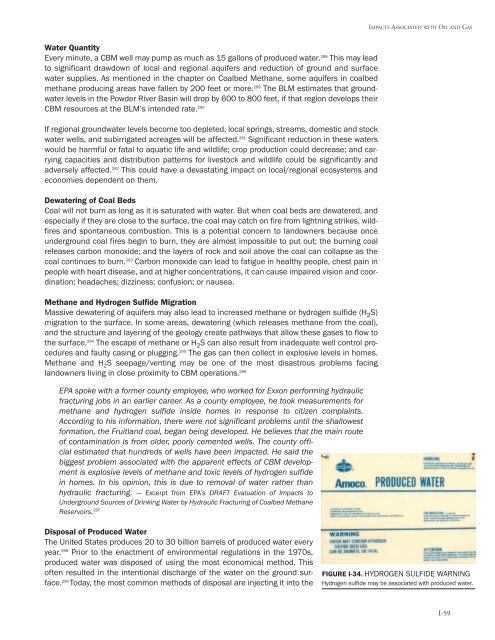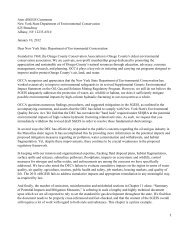Oil and Gas at Your Door? (2005 Edition) - Earthworks
Oil and Gas at Your Door? (2005 Edition) - Earthworks
Oil and Gas at Your Door? (2005 Edition) - Earthworks
You also want an ePaper? Increase the reach of your titles
YUMPU automatically turns print PDFs into web optimized ePapers that Google loves.
IMPACTS ASSOCIATED WITH OIL AND GAS<br />
W<strong>at</strong>er Quantity<br />
Every minute, a CBM well may pump as much as 15 gallons of produced w<strong>at</strong>er. 288 This may lead<br />
to significant drawdown of local <strong>and</strong> regional aquifers <strong>and</strong> reduction of ground <strong>and</strong> surface<br />
w<strong>at</strong>er supplies. As mentioned in the chapter on Coalbed Methane, some aquifers in coalbed<br />
methane producing areas have fallen by 200 feet or more. 289 The BLM estim<strong>at</strong>es th<strong>at</strong> groundw<strong>at</strong>er<br />
levels in the Powder River Basin will drop by 600 to 800 feet, if th<strong>at</strong> region develops their<br />
CBM resources <strong>at</strong> the BLM’s intended r<strong>at</strong>e. 290<br />
If regional groundw<strong>at</strong>er levels become too depleted, local springs, streams, domestic <strong>and</strong> stock<br />
w<strong>at</strong>er wells, <strong>and</strong> subirrig<strong>at</strong>ed acreages will be affected. 291 Significant reduction in these w<strong>at</strong>ers<br />
would be harmful or f<strong>at</strong>al to aqu<strong>at</strong>ic life <strong>and</strong> wildlife; crop production could decrease; <strong>and</strong> carrying<br />
capacities <strong>and</strong> distribution p<strong>at</strong>terns for livestock <strong>and</strong> wildlife could be significantly <strong>and</strong><br />
adversely affected. 292 This could have a devast<strong>at</strong>ing impact on local/regional ecosystems <strong>and</strong><br />
economies dependent on them.<br />
Dew<strong>at</strong>ering of Coal Beds<br />
Coal will not burn as long as it is s<strong>at</strong>ur<strong>at</strong>ed with w<strong>at</strong>er. But when coal beds are dew<strong>at</strong>ered, <strong>and</strong><br />
especially if they are close to the surface, the coal may c<strong>at</strong>ch on fire from lightning strikes, wildfires<br />
<strong>and</strong> spontaneous combustion. This is a potential concern to l<strong>and</strong>owners because once<br />
underground coal fires begin to burn, they are almost impossible to put out; the burning coal<br />
releases carbon monoxide; <strong>and</strong> the layers of rock <strong>and</strong> soil above the coal can collapse as the<br />
coal continues to burn. 293 Carbon monoxide can lead to f<strong>at</strong>igue in healthy people, chest pain in<br />
people with heart disease, <strong>and</strong> <strong>at</strong> higher concentr<strong>at</strong>ions, it can cause impaired vision <strong>and</strong> coordin<strong>at</strong>ion;<br />
headaches; dizziness; confusion; or nausea.<br />
Methane <strong>and</strong> Hydrogen Sulfide Migr<strong>at</strong>ion<br />
Massive dew<strong>at</strong>ering of aquifers may also lead to increased methane or hydrogen sulfide (H 2 S)<br />
migr<strong>at</strong>ion to the surface. In some areas, dew<strong>at</strong>ering (which releases methane from the coal),<br />
<strong>and</strong> the structure <strong>and</strong> layering of the geology cre<strong>at</strong>e p<strong>at</strong>hways th<strong>at</strong> allow these gases to flow to<br />
the surface. 294 The escape of methane or H 2 S can also result from inadequ<strong>at</strong>e well control procedures<br />
<strong>and</strong> faulty casing or plugging. 295 The gas can then collect in explosive levels in homes.<br />
Methane <strong>and</strong> H 2 S seepage/venting may be one of the most disastrous problems facing<br />
l<strong>and</strong>owners living in close proximity to CBM oper<strong>at</strong>ions. 296<br />
EPA spoke with a former county employee, who worked for Exxon performing hydraulic<br />
fracturing jobs in an earlier career. As a county employee, he took measurements for<br />
methane <strong>and</strong> hydrogen sulfide inside homes in response to citizen complaints.<br />
According to his inform<strong>at</strong>ion, there were not significant problems until the shallowest<br />
form<strong>at</strong>ion, the Fruitl<strong>and</strong> coal, began being developed. He believes th<strong>at</strong> the main route<br />
of contamin<strong>at</strong>ion is from older, poorly cemented wells. The county official<br />
estim<strong>at</strong>ed th<strong>at</strong> hundreds of wells have been impacted. He said the<br />
biggest problem associ<strong>at</strong>ed with the apparent effects of CBM development<br />
is explosive levels of methane <strong>and</strong> toxic levels of hydrogen sulfide<br />
in homes. In his opinion, this is due to removal of w<strong>at</strong>er r<strong>at</strong>her than<br />
hydraulic fracturing. — Excerpt from EPA’s DRAFT Evalu<strong>at</strong>ion of Impacts to<br />
Underground Sources of Drinking W<strong>at</strong>er by Hydraulic Fracturing of Coalbed Methane<br />
Reservoirs. 297<br />
Disposal of Produced W<strong>at</strong>er<br />
The United St<strong>at</strong>es produces 20 to 30 billion barrels of produced w<strong>at</strong>er every<br />
year. 298 Prior to the enactment of environmental regul<strong>at</strong>ions in the 1970s,<br />
produced w<strong>at</strong>er was disposed of using the most economical method. This<br />
often resulted in the intentional discharge of the w<strong>at</strong>er on the ground surface.<br />
299 Today, the most common methods of disposal are injecting it into the<br />
FIGURE I-34. HYDROGEN SULFIDE WARNING<br />
Hydrogen sulfide may be associ<strong>at</strong>ed with produced w<strong>at</strong>er.<br />
I-59




